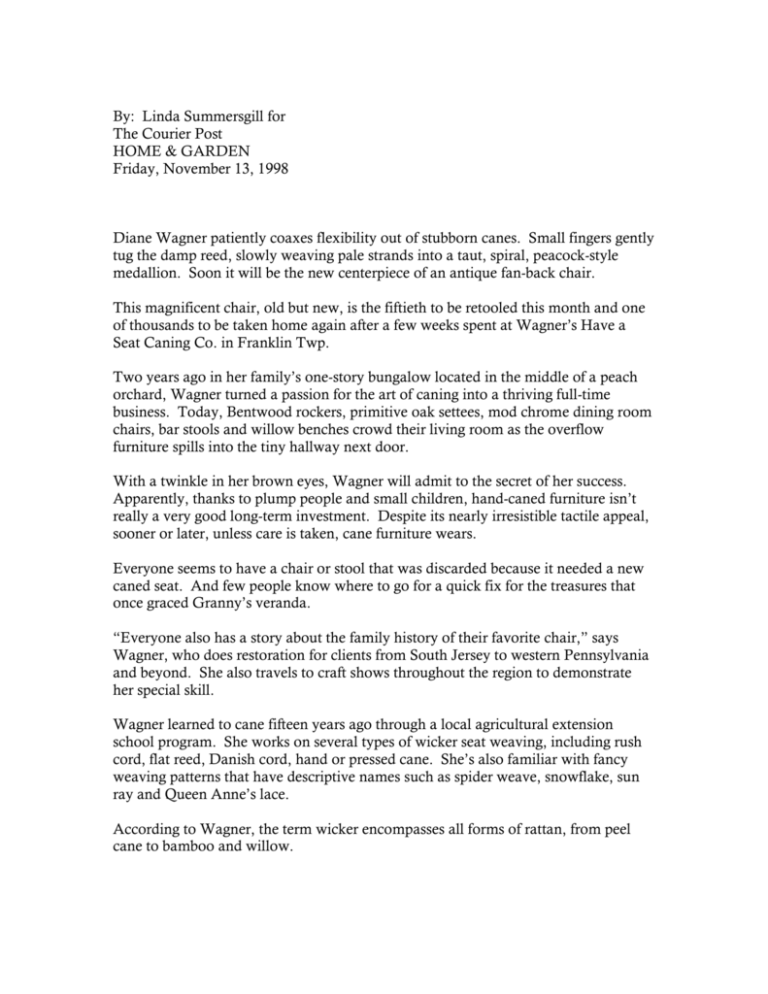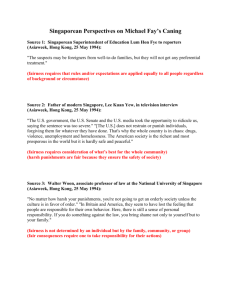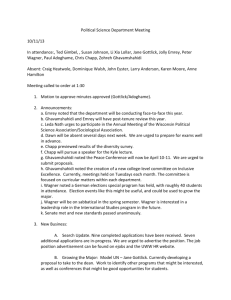By: Linda Summersgill for - Have a Seat Caning Company
advertisement

By: Linda Summersgill for The Courier Post HOME & GARDEN Friday, November 13, 1998 Diane Wagner patiently coaxes flexibility out of stubborn canes. Small fingers gently tug the damp reed, slowly weaving pale strands into a taut, spiral, peacock-style medallion. Soon it will be the new centerpiece of an antique fan-back chair. This magnificent chair, old but new, is the fiftieth to be retooled this month and one of thousands to be taken home again after a few weeks spent at Wagner’s Have a Seat Caning Co. in Franklin Twp. Two years ago in her family’s one-story bungalow located in the middle of a peach orchard, Wagner turned a passion for the art of caning into a thriving full-time business. Today, Bentwood rockers, primitive oak settees, mod chrome dining room chairs, bar stools and willow benches crowd their living room as the overflow furniture spills into the tiny hallway next door. With a twinkle in her brown eyes, Wagner will admit to the secret of her success. Apparently, thanks to plump people and small children, hand-caned furniture isn’t really a very good long-term investment. Despite its nearly irresistible tactile appeal, sooner or later, unless care is taken, cane furniture wears. Everyone seems to have a chair or stool that was discarded because it needed a new caned seat. And few people know where to go for a quick fix for the treasures that once graced Granny’s veranda. “Everyone also has a story about the family history of their favorite chair,” says Wagner, who does restoration for clients from South Jersey to western Pennsylvania and beyond. She also travels to craft shows throughout the region to demonstrate her special skill. Wagner learned to cane fifteen years ago through a local agricultural extension school program. She works on several types of wicker seat weaving, including rush cord, flat reed, Danish cord, hand or pressed cane. She’s also familiar with fancy weaving patterns that have descriptive names such as spider weave, snowflake, sun ray and Queen Anne’s lace. According to Wagner, the term wicker encompasses all forms of rattan, from peel cane to bamboo and willow. Her tools of the trade are elegantly simple things: a well-worn awl, an old golf tee, a small pair of razor-sharp clippers. Caning is in her blood. Wagner’s great-grandfather William and his brother Karl Schober immigrated to Philadelphia in 1890 where they founded one of the country’s oldest basket weaving shops, Charles Schober Co. Later, William ventured into farming in Gloucester County to supply the business’ raw materials. Now living on 40 acres of the family’s home place, Diane hopes some day to pass her heritage on to her son Tristan, 2, and share with him the weaver’s skills and dedication. “Some people cane as a hobby. But even more will say, ‘I tried that once.’ They sound so wistful that they gave up. “I also finish many chairs for people too busy or too frustrated to sit still for three to four hours.” To master caning, experts say, a good eye for critical detail, manual dexterity and a certain pride in workmanship are necessary. Evidence of fine craftsmanship appears when the perimeter of a piece of furniture is flat and tight: holes are even and square; and the cane is new and light colors. Caning is not merely a means for earning an income. For Wagner, it’s something far more precious. “Caning is an art form. Hands and mind work together to join the past with the present. It’s about working with a furniture style which embodies the simplest of materials with the intricacy of complex design.” If you would like more information about caning, contact Have a Seat Caning Company at ( as of 2010 phone # is 856-224-1047).






